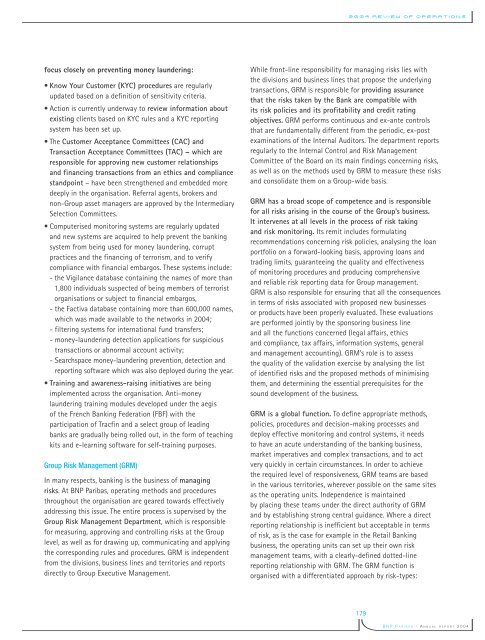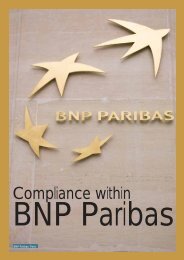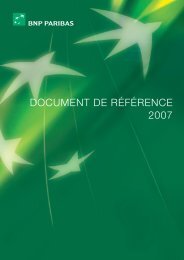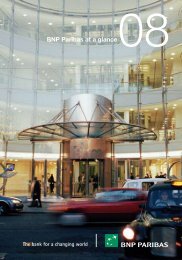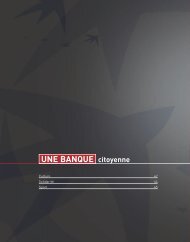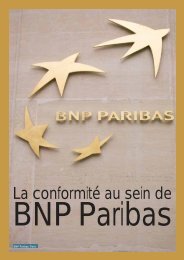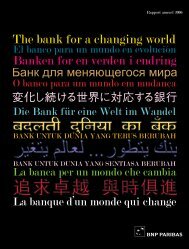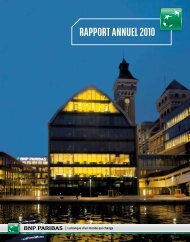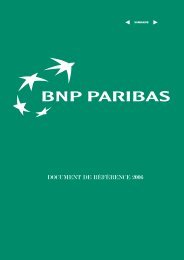La banque d'un monde qui change 2004 - BNP Paribas
La banque d'un monde qui change 2004 - BNP Paribas
La banque d'un monde qui change 2004 - BNP Paribas
You also want an ePaper? Increase the reach of your titles
YUMPU automatically turns print PDFs into web optimized ePapers that Google loves.
<strong>2004</strong> Review of Operationsfocus closely on preventing money laundering:• Know Your Customer (KYC) procedures are regularlyupdated based on a definition of sensitivity criteria.• Action is currently underway to review information aboutexisting clients based on KYC rules and a KYC reportingsystem has been set up.• The Customer Acceptance Committees (CAC) andTransaction Acceptance Committees (TAC) – which areresponsible for approving new customer relationshipsand financing transactions from an ethics and compliancestandpoint – have been strengthened and embedded moredeeply in the organisation. Referral agents, brokers andnon-Group asset managers are approved by the IntermediarySelection Committees.• Computerised monitoring systems are regularly updatedand new systems are ac<strong>qui</strong>red to help prevent the bankingsystem from being used for money laundering, corruptpractices and the financing of terrorism, and to verifycompliance with financial embargos. These systems include:- the Vigilance database containing the names of more than1,800 individuals suspected of being members of terroristorganisations or subject to financial embargos,- the Factiva database containing more than 600,000 names,which was made available to the networks in <strong>2004</strong>;- filtering systems for international fund transfers;- money-laundering detection applications for suspicioustransactions or abnormal account activity;- Searchspace money-laundering prevention, detection andreporting software which was also deployed during the year.• Training and awareness-raising initiatives are beingimplemented across the organisation. Anti-moneylaundering training modules developed under the aegisof the French Banking Federation (FBF) with theparticipation of Tracfin and a select group of leadingbanks are gradually being rolled out, in the form of teachingkits and e-learning software for self-training purposes.Group Risk Management (GRM)In many respects, banking is the business of managingrisks. At <strong>BNP</strong> <strong>Paribas</strong>, operating methods and proceduresthroughout the organisation are geared towards effectivelyaddressing this issue. The entire process is supervised by theGroup Risk Management Department, which is responsiblefor measuring, approving and controlling risks at the Grouplevel, as well as for drawing up, communicating and applyingthe corresponding rules and procedures. GRM is independentfrom the divisions, business lines and territories and reportsdirectly to Group Executive Management.While front-line responsibility for managing risks lies withthe divisions and business lines that propose the underlyingtransactions, GRM is responsible for providing assurancethat the risks taken by the Bank are compatible withits risk policies and its profitability and credit ratingobjectives. GRM performs continuous and ex-ante controlsthat are fundamentally different from the periodic, ex-postexaminations of the Internal Auditors. The department reportsregularly to the Internal Control and Risk ManagementCommittee of the Board on its main findings concerning risks,as well as on the methods used by GRM to measure these risksand consolidate them on a Group-wide basis.GRM has a broad scope of competence and is responsiblefor all risks arising in the course of the Group’s business.It intervenes at all levels in the process of risk takingand risk monitoring. Its remit includes formulatingrecommendations concerning risk policies, analysing the loanportfolio on a forward-looking basis, approving loans andtrading limits, guaranteeing the quality and effectivenessof monitoring procedures and producing comprehensiveand reliable risk reporting data for Group management.GRM is also responsible for ensuring that all the consequencesin terms of risks associated with proposed new businessesor products have been properly evaluated. These evaluationsare performed jointly by the sponsoring business lineand all the functions concerned (legal affairs, ethicsand compliance, tax affairs, information systems, generaland management accounting). GRM’s role is to assessthe quality of the validation exercise by analysing the listof identified risks and the proposed methods of minimisingthem, and determining the essential prere<strong>qui</strong>sites for thesound development of the business.GRM is a global function. To define appropriate methods,policies, procedures and decision-making processes anddeploy effective monitoring and control systems, it needsto have an acute understanding of the banking business,market imperatives and complex transactions, and to actvery <strong>qui</strong>ckly in certain circumstances. In order to achievethe re<strong>qui</strong>red level of responsiveness, GRM teams are basedin the various territories, wherever possible on the same sitesas the operating units. Independence is maintainedby placing these teams under the direct authority of GRMand by establishing strong central guidance. Where a directreporting relationship is inefficient but acceptable in termsof risk, as is the case for example in the Retail Bankingbusiness, the operating units can set up their own riskmanagement teams, with a clearly-defined dotted-linereporting relationship with GRM. The GRM function isorganised with a differentiated approach by risk-types:179<strong>BNP</strong> PARIBAS - ANNUAL REPORT <strong>2004</strong>


